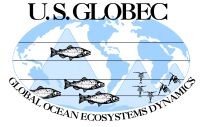August 14, 2002
South fine scale survey continues10:00 a.m.: The fog at
dawn quickly cleared this morning as the Revelle started another
west-bound leg of the fine scale survey. This survey will
continue all day with the SeaSoar and HTI in the water. Plans
call for completing the survey by Thursday morning, locating the most
recently released bio-optical drifters, and performing more station
work. Following that the ship will follow an abbreviated mesoscale survey path from south to north on the way back to Newport.
Shown below is Toby Martin at the SeaSoar winch and a moored NOAA buoy
that was close to this morning's survey line.
.jpg) .jpg) .jpg)
5:00 p.m.: The fog came and went several times today but seems
to have been blown away by the strong winds close to the coastline this
evening. The bird and mammal observation team were out using
their down-filled exposure suits braving the 40-50 knot gusts.
Also seen as we approach the coastline is the dense smoke from the
forest fires on the south Oregon coast.
.jpg) .jpg)
.jpg) .jpg) .jpg)
Chief Scientist Report for 14 August 2002
We have completed lines 8 through 10 on the Fine-Resolution South
grid.
Heavy fog inshore near Port Orford put the bird and mammal observers
out of work for a few hours. There is a great deal of freshly upwelled,
cold, salty water inshore on each of these lines. We went far enough
offshore on lines 8 and 8A to find the offshore temperature and
salinity
front near 125 25'W. Lines 9 and 10 contained mostly freshly upwelled
water, but there was a pool of chlorophyll in the upper 20m centered
on
the middle of each line. That is, very little phytoplankton in either
the
freshly upwelled water right near the coast and very little offshore
of
the front.
Amanda Ashe took a sample for C14 analysis this morning inshore near
Cape
Blanco. The flow-through system continues to work well. Winds picked
up
to 30 knots as we came in toward the coast on line 9. What else should
we
expect south of Cape Blanco! We could clearly see the huge plumes of
smoke coming off the mountain ridges in this area from the forest
fires.
It's awesome. Looks like a volcano plume. I bet these strong winds
aren't helping things.
We expect to finish the Fine-Resolution South grid at the west end of
11A
sometime mid-morning on Thursday. We'll then recover the SeaSoar and
HTI
and head north to find the bio-optical drifters and do some station
work
near them. Then it's off to the Crescent City line to document the
evolution there since we sampled that line a week ago. We've seen big
changes in the near shore properties of the water column, but continue
to
see coherent structure in the offshore mesoscale field.
---Jack Barth, Chief Scientist R/V Roger Revelle
filed 1900 PDT August 14 2002
| |
|
Video Clip
August 14, 2002
Jack Barth describes the pressure on instruments that are lowered
from the ship into deep water. |
 Broadband
version Broadband
version
56k version
|
Previous update August 13
Next update August 15 |


.jpg)
.jpg)
.jpg)
.jpg)
.jpg)
.jpg)
.jpg)
.jpg)


